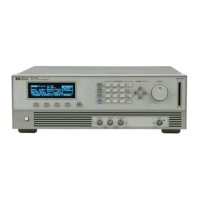HP 8114A Service Guide
Selftest
Power-Up Selftest
The HP 8114A
Selftest
checks only the Microprocessor Board at
power-up. If this test fails you can press
(HELPI
to see a list of the
specific error messages resulting from the test. If the list is longer
than a single screen, use the cursor keys to scroll the list.
Note that a long error list can result from a single initial error.
Therefore, begin to solve problems starting with the first message in
the list and after the problem is cleared run
Selftest
again.
Extended Selftest
The extended
Selftest
tests all installed boards.
Start the extended
selftest
on the
CONFIG
screen:
1. Use the Knob to select
Signal
2.
Press (ENTER].
If the
Selftest
fails, a flashing E is displayed. Press (HELP) to see the
list, of error messages.
Confidence Level
It is not possible to give a Confidence Level figure for the Selftests.
After completion of Performance tests a confidence level of 96% can
be assumed. This is because not all possible settings and functions are
checked by the Performance Tests.
Microprocessor Selftest Failure Messages
The following is a list of the Microprocessor Board error messages and
their meanings. The first part of the list shows the messages as they
are displayed on the instrument. The HP-IB messges are identical, but
with the message:
-330 Self-test failed
added in front.
Selftest
error:
Microproc.
board failed
Hardware failure on the Microprocessor Board
ROM test failed
Flash EPROMs have failed test.
RAM test failed
RAMS
have failed test
Crystal Reference for
UP
lost
Loss of crystal reference. The VCO is running
at approximately half normal operating speed,
determined by an internal voltage reference for
the VCO, instead of the external crystal frequency
VCO for
UP
has not locked
VCO is enabled but has not yet locked. Normally
the VCO locks-on to the required frequency
Unexpected Reset of
UP
Reset was caused by one of the following:
w
Powerup
Reset circuit
n System protection submodule halt monitor
n
loss of frequency reference to clock submodule
5-Z
Troubleshooting

